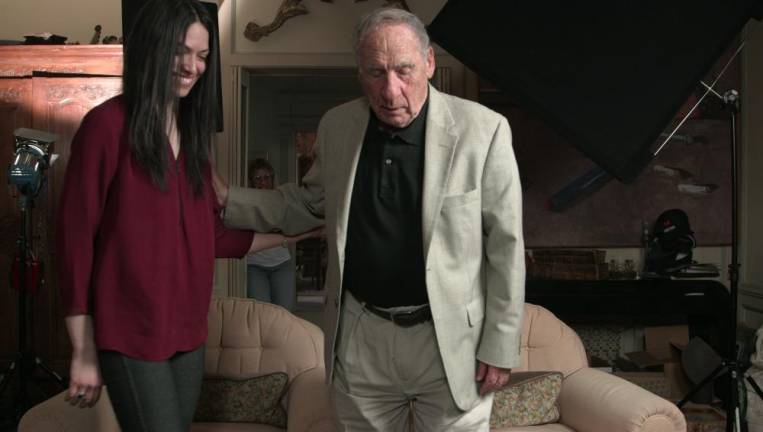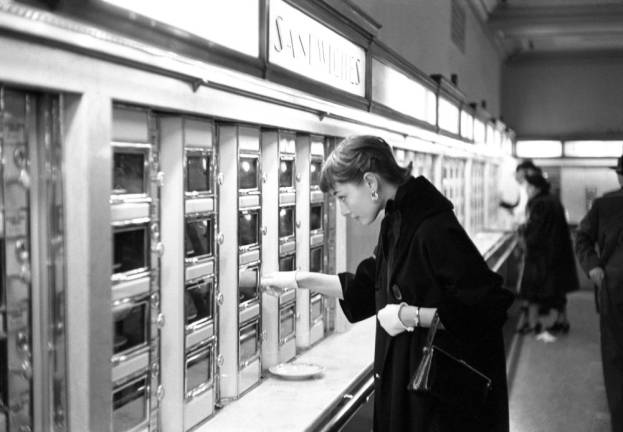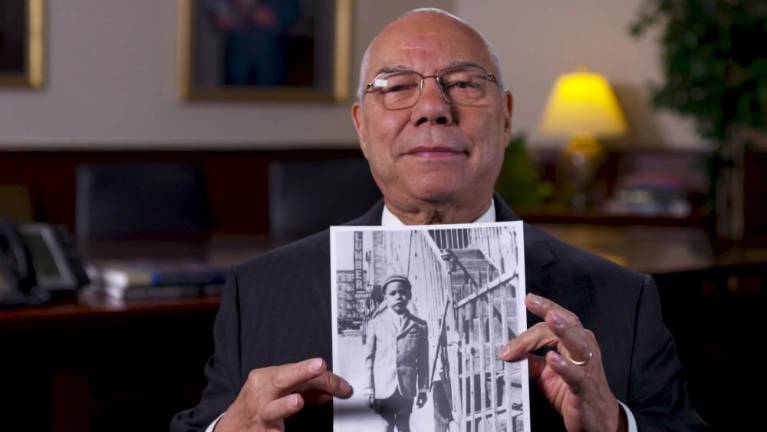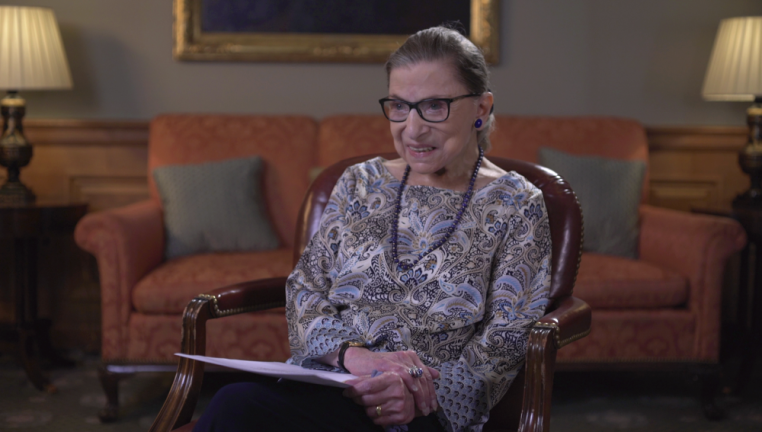When she was a college student, Lisa Hurwitz developed a fascination for cafeterias. Through her early research, she came across the Automat, and having never heard of it before, was brought “down the rabbit hole.” What she could have never imagined back then was that seemingly simple concept would lead her to meeting some of the biggest names in modern-day history, who all share the same love for the iconic New York restaurant chain that now only exists in their memories. (Sadly, the last one, which was located on the corner of 42nd and 3rd, closed its doors in 1991.)
Once she came to the realization that no feature film had ever been done about them, she set out to change that. As we learn in her documentary, “The Automat,” which premieres on Feb. 18 at Film Forum, there were two men behind the innovative food “palaces” that only operated in New York and Philadelphia — Joseph Horn and Frank Hardart. For the project, Hurwitz, a Los Angeles native-turned-Upper West Sider, conducted interviews with the founders’ family members, former employees and even an Automat historian.
She also collaborated with Mel Brooks, a Williamsburg native, who explains in the opening of the film that the Automat — also called Horn & Hardart — “had little glass windows framed in brass with knobs and if you put two nickels into the slot next to the windows, the windows would open up, and you could take out a piece of lemon meringue pie for 10 cents ...” The charming cafeteria chain brought New Yorkers of all walks of life together with its communal seating and its affordable, yet delicious American comfort food like creamed spinach, baked beans and Salisbury steak — and its famous coffee, which was just 5 cents and came out of an ornate spout.
Other highlights include interviews with Ruth Bader Ginsburg, who explained that she took piano lessons on West 73rd, so would frequent the Automat on West 72nd, and Colin Powell, who, as a young boy growing up in the South Bronx, would purchase Horn & Hardart apple pies to bring home to his family.
How did your collaboration with Mel Brooks come about? What was it like to sit down with him?
I had been directing the Olympia Film Festival for a few years. And for one event, we brought Carl Gottlieb, who cowrote the film “The Jerk” with Carl Reiner, for a presentation of “Jaws 3-D,” which he wrote. And he and I became Facebook friends after the event and he noticed my Kickstarter campaign pop up into his newsfeed for “The Automat.” And so he sent me a Facebook message saying that the Automat was an important place for him and he was so excited I was doing the project and that he was gonna be having dinner with his friend Mel Brooks that evening. And so he asked if it would be ok with me if he could mention the film to Mel.
And it wasn’t only sitting down with Mel. It was all the subsequent phone calls and collaborating on the song [Brooks penned a song which plays during the film’s credits]. And it was, I would say, remarkable. He is a genius and I don’t even understand how he can remember all of those little details from his childhood like that.
I love how you did the back-and-forth edits with him and Carl Reiner. That was really funny.
Well, originally we were supposed to interview them together, sitting right next to each other. But Mel was running late and Carl was getting antsy ... Unfortunately, the day that we were filming, Carl wasn’t feeling so well. But I’m glad we ended up doing it the way we did. I don’t know that Mel would have gone for as long, because he was sitting there for a long time with me, and if Carl had been there, I think it would have been a shorter interview. And honestly, it was just so perfect the way that, without even being with each other, that they were talking about the same things. It was really cute. I mean, they were best friends.
My mom grew up in Astoria and would go to the Automat when she came into the city. I called her and asked what she used to eat there, and she said a tuna sandwich. Tell us about its food and the pricing.
I also lived in Astoria; I was there my first two years in New York. They were known for American comfort food and it was this genre that we talk about in the film, that was part of the Americanization process for all of the immigrants who were coming to New York. They really became just this New York staple that everybody would go to. And they were so known for their coffee and for their food. And I would not be surprised that your mom was having a tuna sandwich, that sounds just about right.
They started out with pricing of 5 cents and everything was a nickel. They had a woman called a nickel thrower, who would change dollars into nickels. Over time, with inflation, the prices rose into multiples of nickels at first, because the machines could only accept nickels. Alec Shuldiner, who’s the Automat historian, part of his Ph.D. dissertation’s thesis was how Horn & Hardart got locked into its system, which was part of their failure in the end ... But in the film, you’ll see they did sustain that 5-cent cup of coffee for the longest time.
You also interviewed the founder of Starbucks, Brooklyn native Howard Schultz, whose company was inspired by his experience at the Automat. I thought it was fascinating that he had a framed photo of it in his office.
I know, that was so amazing to find out about him. I didn’t know for the longest time about the connection, and then Marianne Hardart [great-granddaughter of Frank], who’s in the film, at the end of my interview with her, she said, “You know about Howard Schultz, right?” And I said, “No, what are you talking about?” And she just grabbed a book off of her bookshelf and she opened it to the dedication page and there is a picture of the Automat. He dedicated one of his memoirs, that particular one, to the Automat, and I was just so happy to find that out because it was such a rewarding moment ... It was validating for me.
Colin Powell spoke about the diversity at the Automat. Can you tell us about that?
He was an incredible interview and he talks about growing up in the South Bronx, how he and his family, when they would go out to a restaurant, because they didn’t have a lot of money, they went to the Automat. And it was a big deal in their household to go there ... He talks about how it was such a diverse place and how there was no discrimination at the Automat, how it was a very mixed place, and how it was just representative of integrated New York and how he didn’t even remember thinking, “I’m Black. Can I go to Horn & Hardart? Where can I sit?” It was just part of his life.
As for Ruth Bader Ginsberg’s interview, I read that you sent a letter to the Supreme Court after seeing her in “The Sturgeon Queens.”
This is true. Well, she was such a good interview in “The Sturgeon Queens,” which, for those who don’t know, that’s the documentary about Russ & Daughters. And I thought the idea that if she had eaten there, that she would probably have eaten also at Horn & Hardart, which ended up being true. So I just mailed her a letter to the Supreme Court and she wrote me back a letter in the mail. And that’s the same with Colin Powell. It was amazing that I was able to find a photo from the interior of her Automat that she was a regular at.
You feature Horn & Hardart’s vice president of engineering a lot in the film. I saw that you put “In memory of” him at the end.
Thank you for noticing that. I was sad that John [Romas] didn’t get to see the final film. I’m happy though that I did send him DVDs along the way that he played to see in-progress versions of the film and he was just so excited about the film and that I was doing it. I’d call him and check in on him. It was a long time ago now since he died. But early on in the process, like Alec, he was just a great supporter ... I’m so glad we found John because he was this person that everyone who worked at the Automat and the Horns and the Hardarts, everybody knew of him.
www.automatmovie.com



